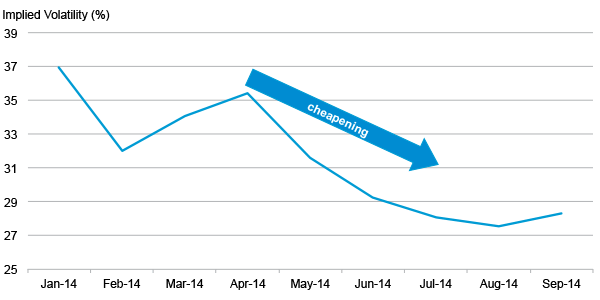
Schroders: Convertible bonds - The best of both worlds?
Schroders investment director Martin Kuehle discusses the merits of convertible bonds, but warns that not everyone is equipped for success when investing in the hybrid asset.
31.10.2014 | 11:01 Uhr
The main driver of performance for convertible bonds is the equity market. Due to the attached conversion right – which offers investors the chance to switch the bond into equity – a strong equity market is good news for investors in convertibles. However, as a hybrid strategy combining equity and bond features, convertibles retain capital protection, which makes them attractive for fixed income investors.
Given that both credit and sovereign yields have fallen to historic lows in 2014, the potential for investors to retain bond-like qualities while potentially benefiting from supportive equity markets makes convertibles a compelling opportunity.The convertible bond market is niche; it is typically characterised by high investor demand but can suffer from periodic patches of low new issuance. This can have a significant effect on convertible valuations in certain segments of the market.
At a regional level, convertible bond market characteristics can also vary widely. Being aware of these differences is integral to generating outperformance. The US convertible market is by far the biggest, most efficient and over the long-run, most fairly priced. On the other end of the spectrum, Asia is the smallest, least liquid market and on average comes with the highest credit exposure. To invest successfully in convertibles therefore, diligent internal research is crucial. This can act as a stumbling block for some market participants, and we believe, has created an inherent undervaluation of convertible bonds.
However, while regional comparison is a useful tool in identifying convertible opportunities, it can also create an overly simplistic view of the convertible bond world. A big advantage for global convertible bond managers such as Schroders is the fact that convertibles are not uniform; the market is both heterogeneous and very dynamic. It is important to have a firm research grip on the whole market, and the relevant modelling skills to pick up either under or overvaluations. Between 2009 and 2013, cheap assets were abundant, but the market now favours global convertible investors with significant research capabilities. Recent selling pressure means that convertibles now look well priced for the asymmetric return profile they offer. Implied volatility, the main measure of quantifying convertible value, stands at under 30%, which gives investors a cheap access right to long running equity market participation.
At the beginning of this year, convertibles in both Japan and Europe looked materially overpriced. Japanese valuations then dropped during April and May after the Nikkei sold off, and the appetite for Japanese convertible bonds declined. The European market also suffered from a correction; after the primary market was flooded with $6.6 billion of new paper in June and $4.5 billion in September. One of the reasons for our underweight in Europe has been the high valuation of European convertible bonds, especially those which have displayed low delta characteristics, which is a measure of the convertible bond’s sensitivity to equity markets. But more recently valuations have dipped, driven by new issuance as well as some outflows from some convertible bond funds.
Valuations becoming more compelling

Source: Schroders as at 30 September 2014 based on constituents of the TRI Global Focus convertible bond index.
Despite all the geopolitical noise, we feel that investors can and should retain a risk-on bias. We still apply an overweight to equity exposure for our fund, and the recent upsurge in market volatility was to be expected. Convertible bonds are suited to these kinds of markets and we believe offer a compelling risk-reward profile.



Diesen Beitrag teilen: